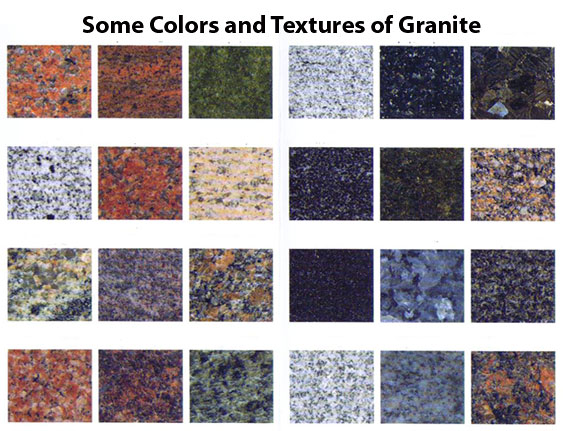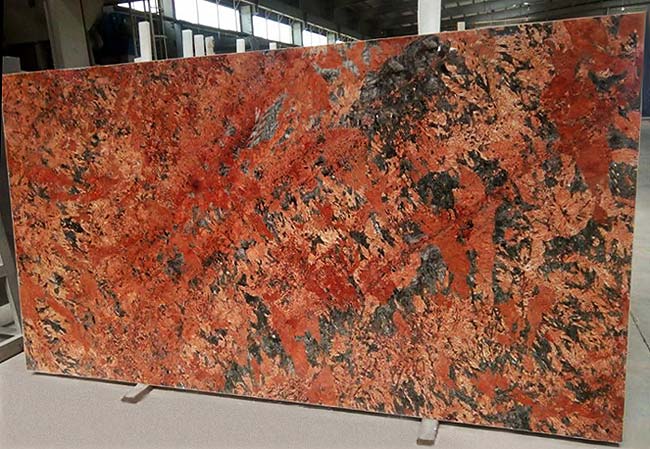Bob's Granite Place is New Hampshire's leading kitchen and bath countertop store. Our large showroom offers the widest regional selection of granite countertops with great monthly specials (links below), and remnant sales So, whether you're looking for a traditional or exotic granite countertop, our showroom and importer network ensure that you'll literally have access to thousands of granite slabs from all over the world!
Granite Countertops New Hampshire - Cost Per Square Foot.
To get a "feel" for pricing, the least expensive industry-standard 3-cm (~1.25-inch) thick black and white granite countertops range from $30.00 to $55.00/square foot. Mid-range granite counters range between $55.00 to $65.00/square foot. Exotic colored granite counters range from approximately $65.00 to $175.00/square foot. In many cases, these costs do not include installation costs.
At this point in time (2024), essentially all granite countertop colors are priced less than similarly colored engineered "quartz" counters. This is because quartz counters are not mined. They're manufactured. This means that during high inflation periods (as we're recovering from now), the raw materials, shipping costs, and the manufacturing process all negatively work together to drive up price. However, because granite is an all-natural material, mining and shipping costs are the primary items impacting its price.
And the pricing variations you will see in granite countertops throughout the U.S. are primarily due to importer location versus showroom location (which impact shipping and transport insurance costs). Showroom stocking contracts are another factor. Fabrication and installation costs for most counters are similar across the country. However, New Hampshire fortunately has no sales tax.
So. please take some time to look over our current featured special, our granite (with sink) specials, and more. We want you to be an informed customer.
Granite Countertop Colors, Names and Images.
Granite countertop coloration can be hard to describe because it usually includes varied amounts of a family of crystalline minerals. These minerals are made up of different elements which result in both a unique distribution of color, but also a 3D coloration - best seen on polished finishes. Due to the subtle distribution of the minerals in various granites, the color patterns within a specific granite countertop "name" will vary ftom slab to slab. So, you can think of your countertop slab essentially as a one-of-a-kind piece of art that will last a lifetime.
 Above: Granite Countertop Color
Chart
Above: Granite Countertop Color
Chart
As for actual granite countertop colors/names, well, that can be a very fuzzy and counterintuitive issue. This is because the "given" colors/names of most countertops no longer correspond to their actual overall coloration (see chart above). Their given names are more often based on a quarry of origin, another material entirely, a materials' region of origin, or a name that is simply "made up.". Chaulk the latter up to marketing.
Fortunately, ALL granite countertops fall into the primary color categories shown in the chart above. These color categories are; black, white, gray, beige, brown, burgundy, red, yellow, green and blue. So, to make things easy on yourself, we recommend you pick a primary color for your kitchen and/or bath first. If you already have a general color picked out, then you might want to view our 48 most popular granite countertop color names (and sample images) for 2024.
Once again, with any granite countertop, the polished finished versions are generally the most remarkable. This is because you can fully "see" and appreciate how light refracts from surface crystals. And as your viewing angle changes, you will see color shifts and twinkling - a property referred to as "depth of color" or "color movement." Note that the color of any countertop can be significantly affected by ambient lighting.Thus, be sure to use similar LED lighting color temperatures in your home!
Below are the typical colors associated with the dominant minerals found in granite:
-
Quartz: Typically milky white, gray or black.
-
Sodium Feldspar: Typically white or off-white.
-
Potassium Feldspar: Typically salmon pink to differing shades of red.
-
Biotite Mica: Typically black to dark brown.
-
Muscovite Mica: Typically metallic in sheen with silver, gold, or yellow hues.
-
Amphibole: Typically black to dark green.

A polished slab of red granite.
Granite Counterops - Composition.
Granites are igneous rocks that cool and crystallize beneath the earth. Geologists classify igneous rocks like granite based on their overall mineral composition. For countertop granites, the primary minerals included are quartz and feldspar. These minerals are extremely hard and make up 70 and 85% of the total mineral content. Micas, amphiboles, and other other trace minerals make up the rest. NOTE: Quartz counters are not natural. To learn more about how they differ from stone counters in composition, functionality and price, see our granite versus quartz countertop comparison article.

Polished fine-grained brown granite.
A few varieties of dark colored granite are actually what geologists consider to be igneous "gabbro." However, even though gabbros contain less than 20% quartz by definition, this variance is compensated for by the higher quantity of feldspar. As a result, they're just as scratch resistant, chemical resistant and heat resistant as other "true" granites.
Due to their popularity and equivalent properties, the natural stone industry long ago somehow accepted these materials as "granite countertops" - even though this is "geologically" inaccurate.

A slab of UbaTuba greenish-black granite.
On Granite Grading.
Granite "grades" or "levels" are usually not discussed when selecting your granite slab. This is because a "grade" is not directly relevant when choosing a granite color or pattern you like. Even more confusing is that granite quarries and importers do not define "grades" in the same way. However, since grading does roughly correlate with material appearance and cost, it's worth a brief explanation.
Granite grades "most often" run from 1-7. Grade 1 granite is generally referred to as commercial-grade granite counters. The varieties in this category have a less complex distribution of colors, are quite abundant and are readily available. Because of this, they tend to cost the least. Grade 1 granites are what home builders often use. Level 2 and 3 granites are also very popular by home builders and home remodelers. They are all quite beautiful. But since they are slightly less plentiful than level 1's, they can be slightly more expensive.
Levels 4 through 7 are pretty much "exotic granites" (see photo below). These materials vary greatly in color/color patterns, are far less plentiful, and are amazingly beautiful. These granites tend to be the most expensive granites, and are most often used for corporate projects or by those who truly love unique granite counters.

An example of an exotic grade 7 granite.
Granite Hardness (or, Resistance to Scratches).
First off, there exists no true "hardness measurement" for countertops. What is often referenced to (incorrectly) is Moh's scale of "hardness." This scale is actually used by geologists to determine relative scratch resistance between minerals (for identification purposes). In any event, granite counters range between 6 and 7 on Moh's scale (with diamond at a "10" and a "5" being steel). Because granite is more scratch resistant than glass and metal kitchen knives, they're as scratch resistant as you'll ever need for indoor or outdoor applications. If you'd like, you can read more about countertop scratch resistance (and other properties) in the following article by the Natural Stone Institute. The article was written by a geologist.
On Porosity.
Some types of granite can be slightly porous. This means that they can hold tiny pockets of water on portions of their outer surface layer. To eliminate porosity, we pre-seal most of our granites using a 15-year nano coating that makes them non-porous - with no impact to the surface finish chosen. There are some that contend that non-porous countertops are best for kitchen use because they might be more resistant to bacterial growth. However, this has not been proven. With ANY countertop, regular cleaning of your countertop surface is absolutely essential to minimize bacterial growth.
Countertop Edges.
All durable countertops require edge treatment during the fabrication phase. This protects both the user and the stone. Treatments can vary from simple "1.25-inch radius edges” to more elaborate edges. Notice the rounded corners and the 3/8-inch radius edges on the top and bottom of the exotic granite countertop shown below.

It's important to avoid sharp corners and edges on any countertop. Rounded or radiused inner and outer corners should be used along with top and bottom edge treatment. Avoiding all sharp edges enhances user safety and reduces the likelihood of cracking and chipping.
Granite Countertop Templating, Fabrication and Installation.
We hope you enjoy the excellent video below on the processes involved in the selection, preparation, fabrication and installation of granite countertops!
